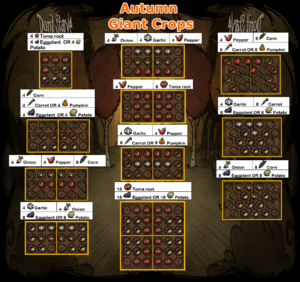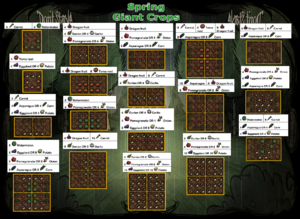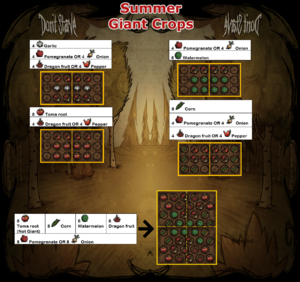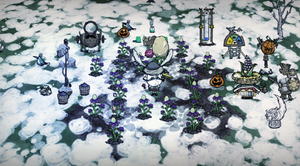Farm Plant
Farm Plants are objects exclusive to Don't Starve Together and introduced in Return of Them. Plant farming provides Food in the form of Vegetables, Fruits, and to some extent Crop Seeds.
Farming
Farm Plants are obtained by planting Crop Seeds or Seeds into Farm Soil. The seeds have a chance to produce weeds instead.
Plants have 5 growth stages: Seeds, Sprout, Small, Medium and Grown. At each new growth stage, the plant may gain Plant Stress points depending on its condition. The total accumulated stress changes the output of a grown plant:
- From 0 to 1 stress point, the plant grows a Giant Crop.
- From 2 to 6 stress points, the plant gives 1 normal product and 2 crop seeds.
- From 7 to 11 stress points, the plant gives 1 normal product and 1 crop seed.
- From 12 or more, the plant gives 1 normal product.
The growth rate of the plant depends on its level of stress: The greater the stress, the slower the growth. Only the stress level gained at the beginning of each stage counts. Growth is twice as fast if the season is one of the plant's favorite seasons. Farm plants only grow in the presence of daylight, i.e. during day and dusk on the surface, near the natural light from the ceiling in the Caves, or near a Dwarf Star.
| Stage | In Season | Off Season | ||
|---|---|---|---|---|
| Low stress | High stress | Low stress | High stress | |
| Seeds | 0.375 - 0.5 | 0.75 - 1 | ||
| Sprout | 1 | 1.75 | 2 | 3.5 |
| Small | 0.6 | 1.05 | 1.2 | 2.1 |
| Medium | 0.4 | 0.7 | 0.8 | 1.4 |
| Total | ~2.5 | ~4 | ~5 | ~8 |
All seeds have a random germination time from 0.75 to 1 day off-season and twice as fast in-season. Random seeds only determine what they grow after germination, with a 20% chance of being a Weed.
Normal products stay 4 days on the plant before rotting and giant products stay 6 days on the plant. If they have been planted by Wormwood, they last 50% longer before spoiling. After 4 to 5 days of rotting, a non-giant plant grows back and the new plant cannot become giant.
If there are 15 or more fully grown or rotten plants within 4 metres radius, the Lord of the Fruit Flies may appear. A Fruit Fly has a 5% chance to spawn when a player picks a non-giant rotten farm plant.
Farm plants are immune to Smoldering as long as they are on wet ground.
Stress
There are 7 sources of stress for farm plants. The condition of the plant is checked at the beginning of each new stage (sprout, small, medium and growth), it can accumulate up to 28 stress points.
Ground Nutrient
![]() See also: Nutrient
See also: Nutrient
There are 3 types of Nutrients and each farm soil tile contains some amount of each nutrient. At the end of each growth stage, farm plants consume and produce nutrients. If the farm soil tile contains fewer nutrients than the plant requires, the plant accumulates 1 stress point and produces fewer nutrients itself. Weeds only consume nutrient and produce none. Fertilizer can be used to increase nutrients in the ground. Because only farm soil tiles can contain nutrients, seeds planted by Wormwood on other tiles will always accumulate 4 nutrient stress points. Nutrient levels can be made easier to see by wearing the Premier Gardeneer Hat. Wormwood can naturally see nutrient levels without the aid of the hat.
Ground Moisture
At each stage, if the plant was on wet ground for less than 10% of the time since the previous stage, it accumulates 1 stress point.
- Each tile has its own moisture, from 0 to 100 points; a non-zero moisture value makes it "wet ground".
- Each use of a Watering Can, a Waterfowl Can or a Water Balloon will add 25 points of moisture. Ice melting will add 20 points of moisture. Rain increases moisture at up to 1.5 points per second depending on the rain rate.
- Moisture naturally decreases, depending on the world temperature, with no drying below 0° to 0.05 points per seconds above 70°, regardless of the time of day.
- Additional plants will drain more moisture per second, regardless of there being any daylight.
- The moisture will never become less than the world wetness, no matter how many plants are on the farm soil tile.
It suffices to water a tile once per stage. Because only farm soil tiles can be Watered, seeds planted by Wormwood on other tiles will accumulate 4 moisture stress points if there is no rain.
Growing under a Dwarf Star reduces water consumption by up to 33% due to earlier maturity.
Killjoys
At the end of each growth stage, the plant accumulates 1 stress point if there are rotten plants, Garden Detritus, rotten giant crops, or weeds within 6m.
Season
At the end of each growth stage, if the current season is not one of the plant's favorites, the plant accumulates 1 stress point.
Additionally, Crops will grow twice as quickly when grown during their preferred Seasons.
Family
At the end of each growth stage, the plant accumulates 1 stress point if there are less than 4, including the one checking, of the same type within 4m.
Overcrowding
At the end of each growth stage, the plant accumulates 1 stress point if there are more than 10 farm plants or weeds on the same tile.
Happiness
At each growth stage, if the plant was not attended to since the last stage, the plant accumulates 1 stress point. Plants can be attended to manually by the player (unless playing as Wes as he is unable to talk) or by using items that attend to all plants within their range (see table).
Plants can be attended to by a Friendly Fruit Fly. Wormwood tends all plants within 4m when he has bloomed. Catching Fire or being attacked by enemy Fruit Flies will undo tending on plants, and the plant will need to be attended to again to avoid stress.
| Item | Range (metres) |
|---|---|
| 25 | |
| 20 | |
| 15 | |
| 12 | |
| 4 | |
| 2 |
Research
Gardeneer hat enables research on crops and weeds, which identify crops, weeds, and seeds in current and future games. Each stage of the crop, and seed, is researchable. Plant registry is accessible by right-clicking on the hat. Among the more useful research is weeds, because the easier they are identified and then killed to avoid stress to other plants.
Summary
Below is a table of all farm plants, their favorite seasons, their nutrient effect (negative is consumption; positive is production), and their drink rate.
| Seed | Grown | Harvest | Crop Name | Season and chance from random seed (the right seasons are green) | Nutrient per stage | ||||||
|---|---|---|---|---|---|---|---|---|---|---|---|
| Autumn | Winter | Spring | Summer | ||||||||
| Random | Random | Random | NA | NA | NA | NA | 0 | 0 | 0 | 0.02 | |
| Toma Root | 13.2% | 8.2% | 12.4% | 15.7% | -2 | -2 | +4 | 0.035 | |||
| Eggplant | 2.7% | 6.6% | 5% | 3.2% | +2 | +2 | -4 | 0.02 | |||
| Potato | 13.2% | 16.4% | 12.4% | 7.9% | +2 | +2 | -4 | 0.0075 | |||
| Dragon fruit | 1.4% | 1.7% | 2.5% | 3.2% | +4 | +4 | -8 | 0.02 | |||
| Pepper | 2.7% | 1.7% | 1.3% | 3.2% | +4 | +4 | -8 | 0.0075 | |||
| Carrot | 13.2% | 16.4% | 12.4% | 7.9% | +2 | -4 | +2 | 0.0075 | |||
| Pumpkin | 5.3% | 6.6% | 2.5% | 3.2% | +2 | -4 | +2 | 0.02 | |||
| Onion | 2.7% | 1.7% | 2.5% | 3.2% | +4 | -8 | +4 | 0.02 | |||
| Pomegranate | 1.4% | 1.7% | 2.5% | 3.2% | +4 | -8 | +4 | 0.02 | |||
| Asparagus | 2.7% | 6.6% | 5% | 3.2% | -4 | +2 | +2 | 0.0075 | |||
| Corn | 13.2% | 8.2% | 12.4% | 15.7% | -4 | +2 | +2 | 0.0075 | |||
| Durian | 1.4% | 1.7% | 2.5% | 1.6% | -8 | +4 | +4 | 0.0075 | |||
| Garlic | 2.7% | 3.3% | 2.5% | 3.2% | -8 | +4 | +4 | 0.0075 | |||
| Watermelon | 2.7% | 3.3% | 5% | 6.3% | -2 | +4 | -2 | 0.035 | |||
| None | Forget-Me-Lots | 15.4% | 15.4% | 15.4% | 15.4% | -2 | -2 | -2 | 0.02 | ||
| None | Fire Nettle Fronds | 1.54% | 1.54% | 1.54% | 1.54% | -2 | -2 | -2 | 0.02 | ||
| None | Tillweeds | 1.54% | 1.54% | 1.54% | 1.54% | -2 | -2 | -2 | 0.02 | ||
| None | None | None | 1.54% | 1.54% | 1.54% | 1.54% | -2 | -2 | -2 | 0.02 | |
Farming Strategy
Farming Strategies generally only work around specialised seeds. Generic seeds are first planted for a single harvest, then the product is fed to a filled Birdcage in order to obtain their specialised Seeds; generic seeds are inferior because of weeds and the randomness in crops.
Weeds are generally a nuisance and should be removed as soon as possible. They generally spawn during the first 5 days of Autumn or Spring, from generic seeds, or could be a returning Forget Me Lot weed, if it was dug up instead of burnt.
Tilling of soil, especially using common crop layout that has 9-10 tills per turf, is generally done through mod, such as geometric placement. The precision needed to till the soil for common crop layout is highly difficult without mods.
Monocropping
Monocropping is a strategy focused only on getting a basic harvest. This strategy does not aim for Giant Crops, mainly aiming for a simple and easily sustainable food source, which requires at least one seed to be returned. Compared to the time and effort of growing and harvesting Giant Crops, Monocropping requires much less effort to produce a harvest, but exchanges that for a somewhat slower and less productive harvest.
Monocropping only requires the care of one of the following: Nutrients, Moisture, or Happiness. Fulfilling one of these needs will ensure a return of at least one seed, allowing for a sustainable Farm that only requires basic care while still providing a fair amount of produce. Since monocropping usually max two nutrients over time at the expense of one, it can be used to prepare plots for self-sufficient crops combination. Potatoes are probably the best tool in this sense. One of the most common crops to get from planting random seeds, potatoes fill the plot with Growth Formula and Compost nutrients while needing to be counterbalanced with Manure (the most comon and plentiful nutrient to find, usually with (were)pigs or beefalos) to have a plot full of nutrients and secured to start self-sufficient combinations.

This fairly basic strategy can very easily be done over multiple farm plots, to provide as much produce as you need, though your Garden Hoes will wear out fairly quickly compared to growing Giant Crops, due to needing more crops to fill the Ice Box.
Growing Giant
The goal of Growing Giant is obtaining as much produce as possible in one harvest, through Giant Crops. This strategy generally makes use of various tactics to take care of as many needs as possible with the lowest possible cost.

Watering is done once per stage, to reduce water consumption. Happiness of the plant is generally handled with tools, either equipping the One-man Band for a second in the center of the farm once per stage, or by the friendly fruit fly. Nutrition is typically handled by crop combinations.
Crop Combinations
Crop Combination is a Planting Strategy aiming to fulfill the crop's nutrition requirement by planting different crop types each consuming a different Nutrient Type, passing Nutrients between them to fill the need while requiring very little maintenance beyond planting the crops.

However, this Strategy requires enough Nutrients in the soil to grow all of the crops in the first place, making it a good idea to add some fertilizer into the soil to work with initially, especially when growing Nutrient intensive crops.
Crop combinations are almost always separated into different sets for each Season, to avoid Seasonal Stress and the slower growth during non-ideal Seasons. Some basic Crop Combinations are listed below, but it is best to assemble Combinations according to individual needs.
The best self-sufficient Giant crops combination considering pure food output, needed input and reliability is 4 potatoes, 4 carrots and 2 garlic on paired plots (to have 4 garlics near each other on 2 different plots). With the maximum of 10 plants on a plot, the maximum allowed to avoid stress. This combination is season-appropriated from autumn to spring. You can replace potatoes with eggplants and carrots with pumpkins in term of nutrients, but they don't match all seasons.

3 dragon fruits - 6 tomatoes for Spring and Summer provides plenty of ingredients for Dragon Pie and Salsa Fresca.
3 Pumpkins - 3 Corn - 3 Potatoes for Autumn provides a good quantity of stable food, but cannot grow Giant.
Here are some more combinations to suit your needs:
6 Carrot - 6 Watermelon / 6 Potato - 6 Tomato / 6 Eggplant - 6 Tomato / 6 Pumpkin - 6 Watermelon
4 dragonfruit - 4 garlic - 4 pomegranate / 4 dragonfruit - 4 garlic - 4 oninion / 4 carrot - 4 corn - 4 potato
3 corn - 3 dragonfruit - 3 pumpkin - 3 tomato / 3 carrot - 3 garlic - 3 pepper - 3 pumpkin
The combinations with less than 4 of the same plant can't grow Giant Crops without the player moisturizing the tile.
Weed farming
Forget-me-lot may be farmed for Soothing Tea. A plot of farm turfs, separate from the main farmland may be left for forget-me-lot to grow. They have to be harvested about every 2 days or else the weed will be too old to be harvested.
Directly farming tomato and onion for Salsa Fresca will be better because they have a lenient harvesting schedule, salsa fresca last longer, and ice is relatively inexpensive.
 Trivia
Trivia
- The Farm Plants were introduced in the Reap What You Sow update.
- The behaviour of a crop growing giant makes a reference to Stardew Valley, in which cauliflowers, melons and pumpkins may grow giant if they're in a 3×3 area.
External Link
- The Starver's Guide to Self-Feeding Farms by QuartzBeam, showing crop combinations and layouts that go with them.
- The List of All Giant Crop, Auto Nutrient Pairings & Fertilizer Pairings by Lakhnish Monster, showing possible giant crop pairings, both self-fertilizing and with unbalanced nutrients.



